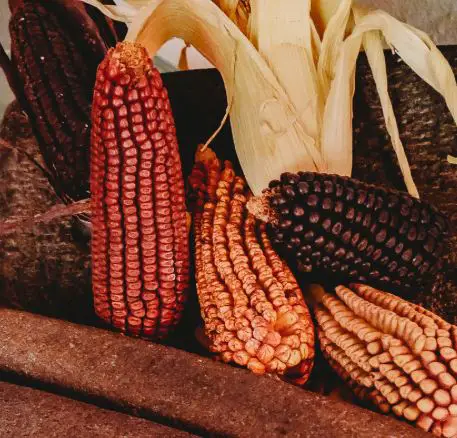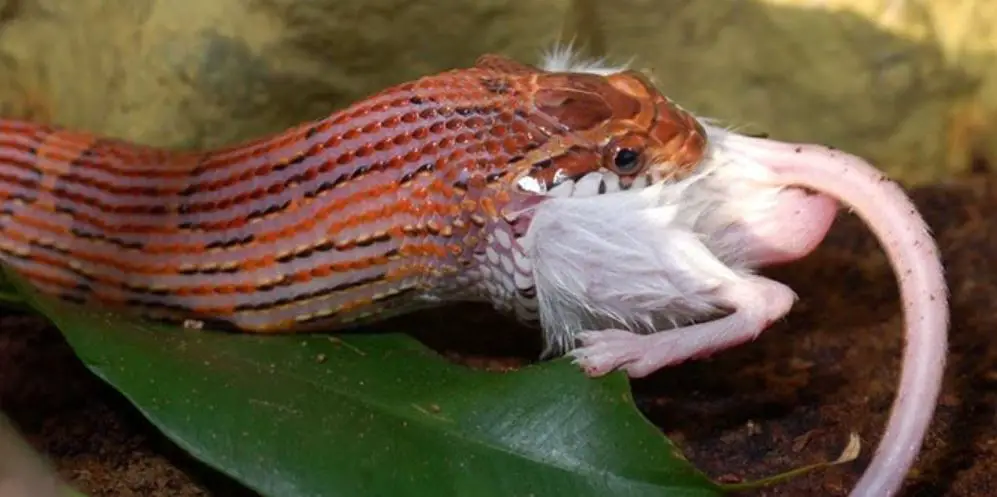Corn Snakes Facts You Need To Know Before Owning One

Corn snakes are long and slender snakes that are found in the wild in the South East of the United States.
They are commonly kept as pets and also found in the wild. These are very interesting snakes so let’s jump into the key facts about these beautiful creatures.
They are friendly and docile in nature
These snakes and non-threatening to humans and these colubrids are rarely aggressive. They will generally only lash out if they feel threatened and even then, very rarely.
They Are Non-Venomous
Corn snakes are non-venomous so even if they do bite they are not dangerous to humans. This is one of the main reasons why they are kept as pets so often.
Make Good Beginner Pets
Given their friendly and docile temperament, they make excellent beginner pets for humans as they are low maintenance and rarely cause problems.
They only eat once or twice per week
Corn snakes only need to eat once or twice a week to keep them going and they swallow their food whole.
Baby snakes eat lizards and frogs
It’s true that corn snakes are carnivores and I like to eat meat. The babies eat lizards and frogs and other small reptiles as this food is easy to catch and digest for the smaller snakes.
Adults feed on rodents & Bird Eggs
Adult corn snakes feed on rodents which is one reason they are very popular with humans because they keep them away from grains and crops where rodents will usually populate. They’re very effective at keeping the rodent population down, making them quite useful to farmers and the public in general as rodents will damage the crops and carry disease.
Adult corn snakes also feed on bird eggs which are packed full of nutrients and protein.
Looks like a kernel of Indian Corn

It is said that corn snakes get their name because they look like a kernel of Indian Corn or perhaps it is because they’re frequently found in cornfields where their prey hangs out.
It also looks like a copperhead
One reason why corn snakes often get killed by humans is because it looks like the venomous Copperhead snake, which can be dangerous, but it can be told apart because of its black underbelly.
It’s a red rat snake
These are a family of large non-venomous there are often found in America.
While they are not venomous they may still bite
If a corn snake feels threatened, it may lash out and bite, although it’s bites are harmless to humans as it is non-venomous. They can strike out at medium range, usually about 1/2 to 1/3 of their body length.
They come in various different morphs and colors

The most common colors found in the corn snake are red-orange, yellow-orange, and sometimes even black.
The body color is determined by the environment
The purpose of the different body colors of the corn snake is to provide as much camouflage as possible in the habitat where they live and Hunt so as to avoid being eaten by larger predators.
Lavender corn snakes are bred in captivity
There are corn snakes with a lavender-colored body but these are bred in captivity and Not Found In The Wild. This attractive color makes them a desirable pet for many.
Corn snakes are diurnal
Corn snakes are active and a Hunt during the day and when they are not hunting they can be found borrowed away safely under leaves and other coverings.
Corn snakes hibernate in the cold
No slate no snakes like the cold and corn snakes are not different, hibernating during the winter months and becoming more active during the summer months.
Most often found Crossing roads
Humans and corn snakes most often crossed paths as the corn snakes are crossing roads during the summer months and are easily visible to humans.
Corn snakes make excellent prey for larger predators
Corn snakes are often hunted and eaten by larger predators such as foxes, skunks, bobcats and even Hawks.
Corn snakes are also eaten by larger snakes
Largest snakes such as King snakes and coral snakes off and feed on corn snakes as their friendly, docile nature means they don’t put up much of a fight.
Corn snakes are constrictors
This means that they wrap around their prey and choke them to death before swallowing them all and one large rodent will cease and adults corn snake for up to 5 days.
The swallow their food whole

There is no chewing involved when it comes to go and snakes they’re large doors open and expand to allow them to swallow large rodents and Reptiles whole in one go.
Corn snakes are not affectionate towards their babies
As soon as a baby corn snake is born it has to fend for itself with little or no help from the parent. That being said these snakes are born with strong Instincts the hunt and if they’re born and suitable conditions they will be easily able to find and kill food from a very young age.
Corn snakes are notorious for escaping Their tanks
Leaving a corn snake in a habitat or a tank in your home that is not fully secure can be a recipe p4 the snake escaping and running loose throughout the home or even getting outside and returning back to the wild.
Corn snakes are colubrids
Corn snakes are one of five colubrid snakes, including the Milk snake and the Kingsnake. Colubrid snakes are identified by the lack of Hind limbs, having no teeth and a significantly reduced left lung size.
The sexually mature between 18 and 36 months
This is when reproduction of corn snakes will typically happen and another snake can lay up to 10 eggs at a time.
Corn snake eggs hatch after 60 days
Corn snakes will Hatch after 60 days and they will immediately begin to hunt and catch their own prey if they are going to survive in the wild.
Corn snakes are Quite large
Corn snakes are born at about 10 – 15 inches long and they are characterized by having slenderbodies, growing up to 72 in as fully grown adults.
Build impressive nests in the world
Corn snakes are known to build nests up year after year, these can sometimes reach weights up to a tonne and diameters of 10 m plus. They generally mate with the same snake of the opposite sex faithfully and they often set up their nests within 100 miles of where they hatched.
Found in the South East of United States
The snakes are often found in the Southeast of the States from Florida, up as far as Mississippi and also often found in North and South Carolina about many order Southeastern States.
They can live up to 25 years in captivity
These snakes can live up to 8 years in the wild and up to 25 years when cared for in a loving environment. This adds to the many existing factors that make these excellent pets and great for children
To Summarise
These are particularly beautiful species of snake and they make perfect pets, especially for beginners. They’re easy to obtain just visit your local pet shop and you can pick one up quite cheaply.


